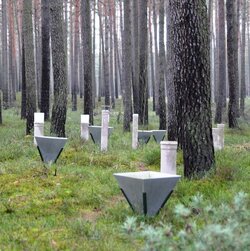Expertise
Looking at the plate: Nutritional status of beech on Level II plots
Inken Krüger | 26.01.2023
As a child you were often told that you have to eat up for good weather. That's nonsense, of course – and yet nutritional status and weather patterns can be directly related, for example in the case of the beech. But what are the food requirements of beech trees on Levell II plots, and how can you tell if it's "full"?
Beech trees bind carbon from the air via photosynthesis and absorb water and nutrients through their roots. These processes depend on radiation, temperature, soil moisture and precipitation. An analysis of data collected since the 1990s as part of intensive forest monitoring (Level II) shows how strong the effects of weather are. Air temperature and precipitation affect the concentrations of all major elements (N, P, K, Ca, and Mg) and the mass of 100 fresh leaves. The leaves studied were from the upper third of the canopy. The effects on leaf mass are stronger than on nutrients. When leaves are large, fewer nutrients are available per leaf. Therefore, the effects of precipitation and temperature on leaf mass and nutrients are often opposite. Significant effects of weather on nutrient ratios were also shown. In general, N:P, N:K, and P:K ratios are less sensitive to weather than nutrient ratios to and between Mg and Ca.
However, apart from the direct and more short-term influences of precipitation and temperature, nutritional status depends on other, longer-term environmental influences such as nitrogen inputs, temperature extremes, precipitation patterns, increases in atmospheric CO2, nutrient uptake (soil), and nutrient availability (roots). Understanding how weather affects indicators helps to better classify long-term trends. This is important because nutrition affects the ability of trees to adapt to global change.
The intensive forest environmental monitoring (Level II) with nationally about 70 selected plots investigates exactly such cause-effect relationships. Thus, it is an important complement to the national Level I monitoring, consisting of the Forest Condition Survey (WZE) and the Soil Condition Survey (BZE). In order to be able to describe the condition and development of selected forest ecosystems, data have been collected continuously since the mid-1990s. The recording of the nutritional status of trees is one of a total of 13 recording areas of the Level II program - the nutritional status influences the growth, resistance and resilience of trees and is therefore one of the most important indicators of the vitality of forest trees.








